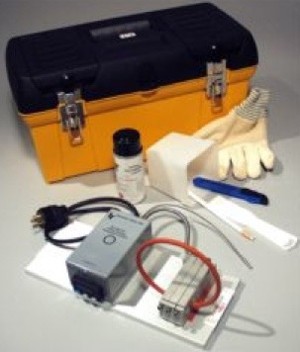 Your maintenance staff can avoid those too-frequent searches for an O Ring of just the right size and material to eliminate make-shift temporary "fixes" by making vulcanized-bond O Rings in the plant.
Your maintenance staff can avoid those too-frequent searches for an O Ring of just the right size and material to eliminate make-shift temporary "fixes" by making vulcanized-bond O Rings in the plant.
A different technique for in-house emergency fabrication of out-of-stock O Rings to make long-term equipment repairs is now being adopted by plant maintenance departments. Maintenance crews in the maritime industry and HVAC business have been using the technique for years.
Among the Viton O Ring seals made on-the-spot have been dynamic seals for reciprocating shafts and rotating shafts, as well as static seals. The permanence of the repair is attributable to use of an O Ring kit that combines a vulcanizing procedure with appropriate material adhesive. The results are said to be comparable to the quality of a factory-made ring.
A vulcanized bond is less likely to fail in service because the homogeneous linked bond has greater pull strength and greater chemical resistance than an instant adhesive bond. At one New Jersey company, being able to make a vulcanized O Ring fast and on-the-spot avoided loss of a $70,000 batch of product from a chemical reactor, plus the cost of disposal of the unreclaimable product. The ring was a 60-inch size with 1/4" cross section.
In- house fabrication speeds repairs when required O Ring sizes are not at hand. Delays for trips to mill-supply houses are eliminated, as are problems of closed suppliers over weekend and holidays.
Plant maintenance personnel familiar with adhesive-bond kits find them valuable, but report that adhesive-bonded rings are only a temporary repair that often must be re-done with a permanent replacement. In contrast, they call the newer vulcanized-bond ring a permanent repair. They find a vulcanized-bond ring often can be made in less than 20 minutes. In addition, those using the newer vulcanizing kits have been able to reduce ordering paperwork and O Ring inventories.
The technique for making vulcanized-bond rings in-house works for inch or metric rings.
A ring-vulcanizing kit contains everything necessary: a work board, cutting blades, cord marking pen and thermally insulated glove and cooling pan. On the work board are a straight and bevel cutting die. Temperature-controlled 110-volt heater and vulcanizing die. A typical vulcanizing die handles eight cord sizes in inches or five cord sizes in mm. The die is removable from the heating element for substitution of another die for other cord sizes or cross sections. (custom dies available in inch or metric sizes).
Some Viton cord is reprocessed material, rather than virgin material. But the best ring fabrication results are obtained with virgin material Viton cord. Unlike reprocessed Viton , the virgin material typically has better chemical resistance, a higher maximum operating temperature, and a better shape-retention memory. Also it is easily bonded during vulcanization.
The procedure for making a Viton ring takes less than 20 minutes.
Viton is a registered Trademark of E.I. Dupont